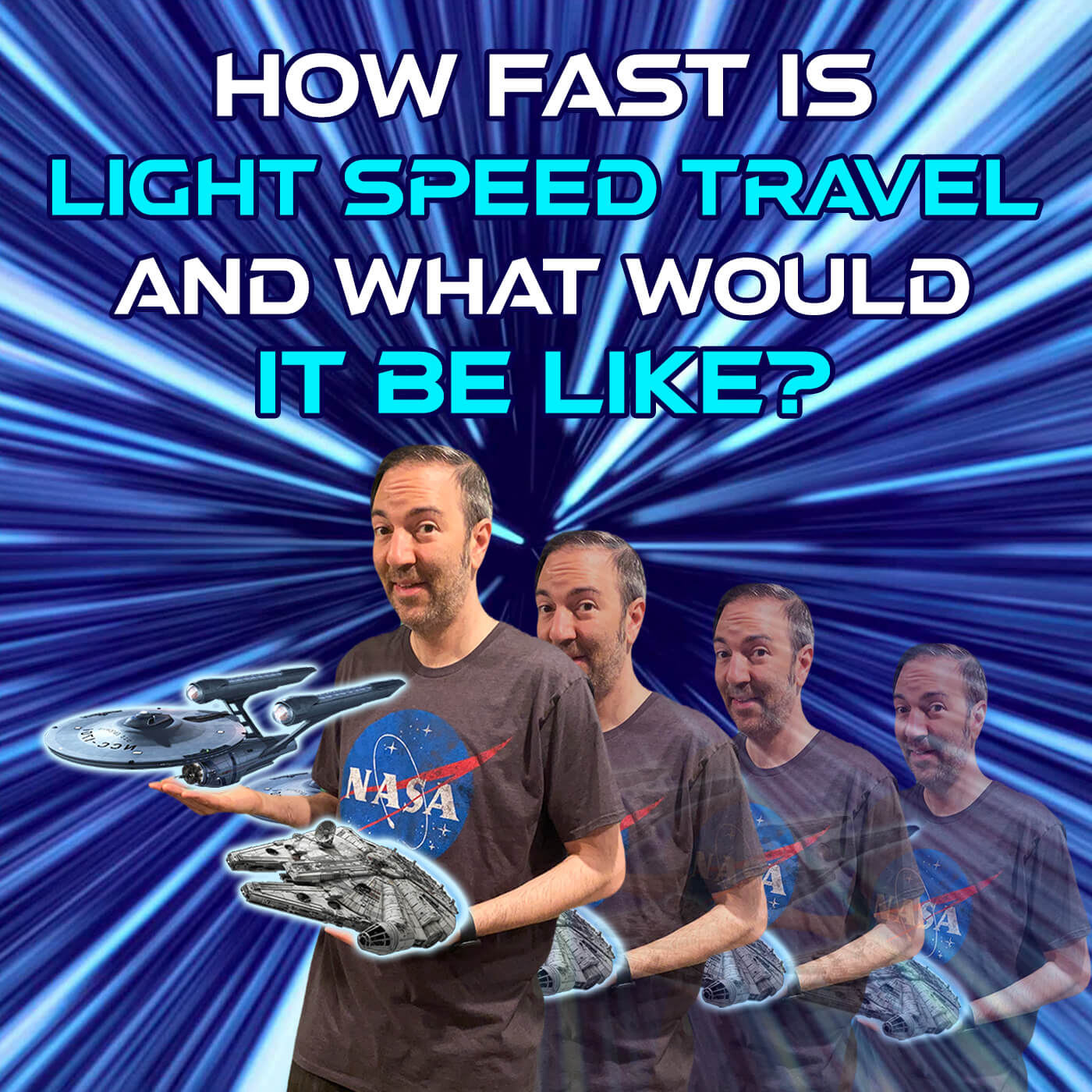Future Tech: How fast is light speed travel and what would it be like?

In this episode I talk about light speed travel. Not only how exciting it is, but how fast it is, and how it’s kind of like time travel. I will also cover NASA’s theoretical helical engine which supposedly can travel at 99% the speed of light. For those of you who aren’t familiar with light speed travel, of course, we can’t travel 186,000 miles per second yet. But you’re seen it in Star Wars when they activate the hyperdrive and travel through hyperspace. Or in Star Trek when they activate the warp drive and travel through space at huge multiples of light speed. Today I’ll tell you some distances we could travel as well as how light speed works. So get ready to enter hyperspace and hang onto your seats!
Listen to the Podcast episode here:
Or Watch the Video here:
Here’s the transcript from this podcast episode, please excuse any typos!
In Star Wars or Star Trek, when they activate the hyperdrive or the warp drive, you’ll notice the light is moving really fast past them, and then all of a sudden you notice they start having conversations, and they start going to get some food and they start training and they start going to sleep. Because light speed travel although it’s fast. You have to travel through space to get to your destination. And light speed travel is 186,000 miles per second. So get your laser pointer and your cat and start pointing the laser pointer and make the cat chase. You see how fast that laser pointer hits an object. I mean, if you want to go outside at night and hit a wall very far away. You can do that because the latest traveling so fast, it’s the blink of an eye and Lightspeed travel means that if you’re a superhero, and you have super speed, and you can travel the speed of light, you could go all the way around the Earth seven and a half times in one second. So as much time as it takes you to blink your eyes is how fast somebody can go around the Earth seven and a half times. Let’s compare that to a jet plane, jet aircraft, budget aircraft and go from the East Coast to the West Coast of the US in four hours. 500 miles per hour. So we’re slow.
So let’s talk about one of our neighbors. Neptune Neptune is pretty far away. And I believe it’s four light hours away. So how long would that take us? You know to get there Lightspeed travel we can get to Neptune in four hours. But if we’re traveling, you know, the regular spaceships that we have, it’s gonna take us years to get there. You know Mars takes us almost one year right now and takes us like seven months to drop off our rovers and our robots up there. But with Lightspeed travel, we can get there in 12 minutes, just like a quick subway stop. And let’s talk about the moon. The moon takes a couple of days to get to but we get there in one second, with light speed travel. So light speed and time travel. like Einstein came up with the theory of relativity, the space time continuum and all those things right and he talked about light speed as well. We have to think about things like this. When you see the Hubble Space Telescope or the James Webb telescope or any telescope showing us images of far off billion light years away, distant galaxies and stars and planets and all sorts of cool black holes to light that those phenomena are emitting take light years to travel to us. Think about that. The images we’re seeing happened, we’re seeing the past. Right? We’re traveling through time. Let’s say the James Webb Telescope recently showed us a cluster of galaxies that supposedly is like 100 or 200 million years after the Big Bang which is crazy to think about how close to the Big Bang we can see now. But that happened billions of years ago. So billions of years ago, those images happened. And we’re seeing them today. But the light had to travel to us in order for us to see them. Yeah, it’s crazy to even think about it I understand but let’s do a time travel example from the movie Interstellar by Christopher Nolan, if you haven’t seen it, Matthew McConaughey and Hathaway when they had to leave the ship to go onto a planet that suffered time dilation. So for every minute on the planet, it was like an hour or a day, actually or even longer than that on the ship outside of the atmosphere of the planet.
So the crew was on the ground doing some stuff on the planet for like 10 minutes. Nothing crazy. But up there on the ship, the poor crew member that was left there, it was like a decade. He was there for years and years. So when they got back up there, he was an old man. And he kind of went crazy because he was all by himself on the ship. Wait. So time works funny like that. And if we could travel fast enough, Lightspeed travels 186,000 miles per second. If we could travel that fast, let’s say you have a twin, and you’re on Earth, your twin gets on a spaceship that can travel that fast. hyperspeed, whatever you want to call it, and they take off towards Alpha Centauri, which is one of the closer it’s like four light years away from our solar system. It’s one of the closest stars outside of the Milky Way. Alpha Centauri. So we’re going to travel four light years to Alpha Centauri, which is really millions or billions of miles, because we have to do the math on how long that takes. Your twin is staying behind in normal time. The other twin is traveling faster than the speed of light or the speed of light, which means you’re going towards the past or towards the future.
I’m not quite sure it’s I’m not a physicist, but I do know that you’re beating time, because time stays still for the person on earth, the stationary person, whereas you are trapped, Time moves slower for Lightspeed Time moves slower, because you’re you’re kind of beating it you’re going through it, whereas time stays still where you’re at. So I had to stop for a second to do some math because I was curious about this and at the speeds that we currently have available. It would take us 75,000 years to get to Alpha Centauri. But supposedly, they’re working on some laser driven light sales to send some probes to Alpha Centauri and at 15%, the speed of light that would take 25 years. So that’s not as bad. But we really need something to do at lightspeed. If we can do Lightspeed travel, then we could most likely, I mean, think about it. We can get to Mars in 12 minutes. But maybe we can get to Alpha Centauri in a month, using Lightspeed travel. But that’s kind of my point when you’re again when we’re talking about Star Wars and Star Trek. watch those movies again when they travel through hyperspace or warp drive or wormholes or whatever. And you see the lights flashing. And then after a while, you just kind of see the lights flashing and they’re just carrying on with their business because it takes time. You know, they got that right. It takes them time to travel those distances. A lot of times, it’ll even say how, you know how long till we get there? And they’ll say, you know, a couple days or a couple hours or whatever it is.
So NASA engineer David Burns theoretically came up with this helical engine concept, which is pretty cool. On paper. Imagine a box with a string inside with a weight on it, that goes back and forth, back and forth. As it’s going back and forth. It’s causing momentum. It’s making the box wiggle a little bit, which is giving it thrust and the weight is going faster and faster and faster until eventually some force adds a little bit of extra weight on one of the sides of this string, which is causing this box to thrust forward. Okay, so you got that. Now imagine it’s a ship and inside it has ions going either back and forth, or around and those ions are going faster and faster and faster, and causing more thrust or force in a certain direction. Well, theoretically, this could be fast enough, the ions can give the thrust to make us go 99% And that’s, you know, 99% speed light is better than nothing at all. 100% speed of light is 186,000 miles per second. If we can go 175,000 miles per second, we’re still that’s it. We can get to Mars in 15 minutes instead of 12 minutes. Big deal. So theoretically, if this drive would work, we could start traveling far, far distances in a fraction of the time like we do in the movies. Until then, we have to only see thank God we have telescopes to see these light year away galaxies and stars.
And in order to go that fast, our bodies would have to be able to handle it. Obviously, in these spaceships in the movies, they don’t really explain how they can travel through those distances without hurting our bodies. I guess there’s some sort of artificial gravity onboard. We don’t have artificial gravity either. So we’d have to figure that one out. But one thing is for sure, as Einstein mentioned in his theories of relativity and space time and time dilation as a traveler moves at a high velocity away from Earth, and it’s gravity, that traveler experiences a different time than the stationary person on earth. So essentially, a traveler going at the speed of light to Alpha Centauri essentially becomes a time traveler. And that’s a fact. I would love to hear your feedback. I always answer them. I’m fascinated by Lightspeed travel in space and anything regarding time dilation, time travel, interstellar travel, so leave me some comments. I’m curious to hear your thoughts. On Lightspeed travel and I will get back to all of you. And as always, I will see you in the next episode.
![]()





